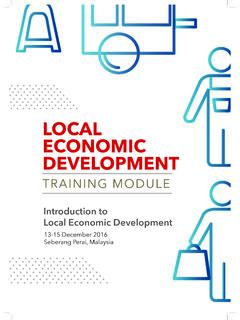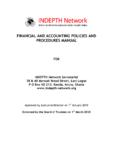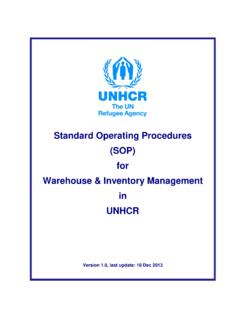Transcription of Guide to Municipal Finance - Local2030
1 Guide to Municipal Finance Guide to Municipal Finance Nairobi, 2009. Sec1:i The Human Settlements Financing Tools and Best Practices Series Guide to Municipal Finance First published in Nairobi in 2009 by UN-HABITAT. Copyright United Nations Human Settlements Programme 2009. All rights reserved United Nations Human Settlements Programme (UN-HABITAT). P. O. Box 30030, 00100 Nairobi GPO KENYA. Tel: 254-020-7623120 (Central Office). HS/1146/09E. ISBN: 978-92-1-132113-5. ISBN(Series): 978-1-132027-5. Disclaimer The designations employed and the presentation of the material in this publication do not imply the expression of any opinion whatsoever on the part of the Secretariat of the United Nations concerning the legal status of any country, territory, city or area or of its authorities, or concerning the delimitation of its frontiers of boundaries.
2 Views expressed in this publication do not necessarily reflect those of the United Nations Human Settlements Programme, the United Nations, or its Member States. Excerpts may be reproduced without authorization, on condition that the source is indicated. Cover design : Andrew Ondoo/UN-HABITAT. Cover photos: Xing Quan Zhang/UN-HABITAT. Acknowledgements: Director: Oyebanji Oyeyinka Principal Editor and Manager: Xing Quan Zhang Principal Author: Enid Slack English Editors: Eric Orina and Cilla Ng Design and Layout: Andrew Ondoo ii Table of Contents chapter 1 Definition of Municipal Finance and Objectives of the Guide 1. Definition of Municipal Finance 1. Objectives of the Guide 1. Outline of the Guide 2. chapter 2 Municipal Finance Issues, Challenges, and Trends 3.
3 State of Municipal Finances 3. Issues and challenges 10. Recent trends in Municipal Finance 14. chapter 3 Principles of Municipal Finance 17. Role of local government in the economy 17. Major functions of Municipal governments 18. The benefit model of local government Finance 18. public Finance principles 19. Chapter 4 Municipal Revenues 21. Sources of Municipal revenue 21. Characteristics of a good local tax 22. Taxes 23. User fees 33. Intergovernmental transfers 35. Types of transfers 35. Rationale for transfers 36. Design of transfers 38. Problems with transfers 38. Implementation and management of Municipal revenues 40. chapter 5 Financing Capital Expenditures 41. Funds from operating revenues 41. Intergovernmental transfers 42. Mobilizing private capital 42.
4 Municipal borrowing 43. public -private partnerships 44. Development charges 45. Tax increment financing 50. Land value capture taxes 54. iii chapter 6 Municipal Budget, Financial Reporting and Auditing 56. Expenditures at the local level 56. Municipal budgeting 56. accounting standards 61. accounting concepts 62. Auditing 63. Performance-based measurement 63. chapter 7 Municipal Borrowing and Access to the Capital Market 65. Role of Municipal borrowing 65. Capital markets 66. Pooling Municipal debt 66. Borrowing instruments 67. Credit ratings 68. chapter 8 Concluding Comments 71. REFERENCES 78. appendix 78. iv LIST OF TABLES ,FIGURES AND boxes Tables Table 1 Distribution of Municipal Expenditures, Selected OECD Countries, 2006 (%) 4. Table 2 Distribution of Municipal Expenditures, Selected Countries in Central and Eastern Europe, Asia, Africa, and Latin America, 2006 (%) 5.
5 Table 3 Distribution of Municipal Revenues, Selected OECD Countries, 2006 (%) 6. Table 4 Distribution of Municipal Revenues, Selected Countries in Central and Eastern Europe, Asia, Africa, and Latin America, 2006 (%) 7. Table 5 Local Government Expenditures as a Percentage of GDP. and Total Government Expenditures 9. Table 6 Urban Population by Major Area, Selected Periods, 1950-2050 10. Table 7 Percentage Urban by Major Area, Selected Periods, 1950-2050 11. Table 8 Sources of Municipal Operating Revenues for Selected Cities 22. Table 9 Base for property Taxes 27. Table 10 Types of Intergovernmental Fiscal Transfers 36. Table 11 Development Charges, Greater Toronto Area, 2007 49. Table 12 The Steps in the Capital Budget 58. Figures Figure 1 public Debt, Spending and Investments the Role of Local Governments (2000) 15.
6 Figure 2 Different Financing Tools for Different Services 18. Figure 3 Calculating the Tax Increment 53. Figure 4 Steps in the Budgetary Process 59. Boxes Box 1 public Finance Principles 20. Box 2 Characteristics of a Good Local Tax 22. Box 3 How property Tax Capitalization Works 23. Box 4 Road Pricing in Singapore 34. Box 5 public Finance Principles for Designing Fiscal Transfers 39. Box 6 Types of public -Private Partnerships 44. Box 7 Calculating Development Charges 47. Box 8 Implementation of Tax Increment Financing 50. Box 9 Steps for Tax Increment Financing 52. Box 10 Citizen Involvement Participatory Budgeting in Porto Alegre 60. Box 11 Municipal Finance and Management Initiative in Ghana 67. Box 12 Illustration of a Tax-Free Bond 67. v ABBREVIATIONS AND ACRONYMS.
7 CBD Central Business District ERPS Electronic Road Pricing System GDP Gross Domestic Product IMF international Monetary Fund ipsas international public sector accounting standards IU In-vehicle unit GAAPs Generally Accepted accounting Principles MDGs Millennium Development Goals OECD Organisation for Economic Co-operation and Development PAYG Pay-as-you-go P3s public -Private Partnerships TIF Tax Increment Financing VAT Value added tax vi FOREWORD. The global housing And for this, we need innovative governance, crisis, especially in and local thinking and reporting if we are the developing world, to bring hope to the urban poor. Equally is getting worse by importantly, we need to support our towns the day making the and cities, indeed our countries, to adopt pro- right to adequate poor policies and strategies that will obviate shelter a quest that is the need for further slum creation.
8 Becoming more and more difficult to meet, It is against this background, that the Human despite the targets set Settlements Financing Tools and Best by the Millennium Development Goals. Practices series focuses on the development of know-how, knowledge and tools in human Such is the rate of urbanization the influx of settlements financing, from which Member people into towns and cities, and their natural States can learn in delivering affordable growth that the world has now reached a housing to the poor. point where for the first time now, half the global population lives in towns and cities. By the year 2050, six billion people two- thirds of humanity will be living in towns and cities. And as urban centres grow, the locus of global poverty is moving into towns and cities, especially into the burgeoning informal settlements and slums, of the developing world.
9 In the developing world, this is happening so fast that slums are mushrooming in what is termed the urbanization of poverty. This makes it imperative that we use every means at our disposal to ensure that we at UN- HABITAT, and our partners, keep applying Anna Tibaijuka, ourselves to Target 11 of the Goals to achieve Executive Director, UN-HABITAT. significant improvement in the lives of at least Under-Secretary-General of 100 million slum dwellers, by 2020. the United Nations, vii viii Definition of Municipal Finance and Objectives of the Guide CHAPTER 1. Definition of Municipal Finance and Objectives of the Guide Interest in cities around the world is on the rise, OBJECTIVES OF THE Guide . in large part, because more and more people The objective of this Guide to Municipal are living in cities in both developed and less Finance is to introduce government officials, developed countries.
10 The rapid increase in the policy makers, professional practitioners, civil urban population has put pressure on local society, and academics in UN member states governments to provide a range of services to the current issues in Municipal Finance from water and sewer infrastructure to social in countries around the world. The Guide services and housing. To meet the rising emphasizes the important role that Municipal demands of urbanization, municipalities need Finance plays in local service delivery, adequate revenue tools to pay for services and particularly in the context of globalization, infrastructure. decentralization, and a focus on sustainable development. It highlights some of the new DEFINITION OF Municipal Finance trends in financing services that are being used in different countries around the world Municipal Finance is about the revenue such as increased reliance on the private and expenditure decisions of Municipal sector to invest in infrastructure and services.







